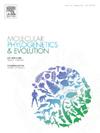Forget-me-not phylogenomics: Improving the resolution and taxonomy of a rapid island and mountain radiation in Aotearoa New Zealand (Myosotis; Boraginaceae)
IF 3.6
1区 生物学
Q2 BIOCHEMISTRY & MOLECULAR BIOLOGY
引用次数: 0
Abstract
Island and mountain systems represent natural laboratories for studies of species radiations, but they often present several challenges for phylogenetic inference and species delimitation. The southern hemisphere forget-me-nots (Myosotis, Boraginaceae) comprise a geologically recent radiation centred in Aotearoa New Zealand, a mountainous archipelago, with about 50 species that are morphologically and ecologically divergent but lack genetic variation sufficient to resolve phylogenetic relationships and species boundaries using standard DNA Sanger sequencing markers, AFLPs, or microsatellites. Many of these Myosotis species are geographically restricted in alpine areas, uncommon or threatened, have polyploid and dysploid genomes, and are of high taxonomic and conservation priority. Here we present phylogenomic analyses using target-capture of Angiosperms353 baits, and genome skimming of whole plastomes and nrDNA, to improve resolution of the radiation, explore biogeographic and morphological patterns within it, and address specific taxonomic questions for each species. Our comprehensive sampling includes over 300 individuals representing nearly all species from New Zealand and Australia, which is ∼ 2–3 × more taxon sampling and ∼ 80–120 × more molecular data than previously published for Myosotis. Exploration of different data filtering, curation and analyses (coalescent vs. concatenation) improved the resolution of the Angiosperms353 tree, which despite short backbone branches with low support values, showed taxonomic and geographic patterns, including multiple switches between ebracteate and bracteate inflorescences and multiple expansions within New Zealand from Te Waipounamu South Island to Te Ika-a-Māui North Island, Rakiura Stewart Island, subantarctic islands, and Australia. Some of these patterns were also seen in the genome skimming datasets, and comparison of the three datasets was useful for improving our understanding of the taxonomy and resolution of this radiation. Although this phylogenomic study does not fully overcome all of the challenges regarding species delimitation of this rapid island and mountain species radiation, it nevertheless makes an important contribution to an integrative taxonomic revision of the southern hemisphere species of Myosotis.

勿忘我系统发生组学:提高新西兰奥特亚罗瓦岛和山区快速辐射的分辨率和分类学(Myosotis;Boraginaceae)。
岛屿和山地系统是研究物种辐射的天然实验室,但它们往往给系统发育推断和物种划分带来一些挑战。南半球的勿忘我(Myosotis,博拉金科)是以新西兰为中心的新近地质辐射,该群岛多山,约有 50 个物种,它们在形态和生态上存在差异,但缺乏足够的遗传变异,无法使用标准的 DNA 桑格测序标记、AFLPs 或微卫星来确定系统发育关系和物种界限。其中许多妙蛙属物种在地理上局限于高山地区,不常见或濒临灭绝,具有多倍体和二倍体基因组,在分类学和保护方面具有很高的优先性。在此,我们利用目标捕获的 Angiosperms353 诱饵以及全质粒和 nrDNA 的基因组撇取技术进行了系统发生组分析,以提高辐射的分辨率,探索其中的生物地理学和形态学模式,并解决每个物种的具体分类问题。我们的综合取样包括 300 多个个体,几乎代表了新西兰奥特亚罗瓦和澳大利亚的所有物种,这比以前发表的妙蛙花分类群取样多 2-3 倍,分子数据多 80-120 倍。对不同数据过滤、整理和分析(聚合与合并)的探索提高了 Angiosperms353 树的分辨率,尽管该树的主干分支较短且支持值较低,但仍显示出分类学和地理学模式,包括无苞片和有苞片花序之间的多次切换,以及新西兰境内从 Te Waipounamu 南岛到 Te Ika-a-Māui 北岛、Rakiura Stewart 岛、亚南极岛屿和澳大利亚的多次扩展。其中一些模式也出现在基因组取样数据集中,对这三个数据集进行比较有助于提高我们对这一辐射的分类和分辨率的理解。尽管这项系统发生组学研究并没有完全克服这一快速的岛屿和山地物种辐射所带来的物种划分方面的所有挑战,但它对南半球妙蛙属物种的综合分类学修订做出了重要贡献。
本文章由计算机程序翻译,如有差异,请以英文原文为准。
求助全文
约1分钟内获得全文
求助全文
来源期刊
CiteScore
7.50
自引率
7.30%
发文量
249
审稿时长
7.5 months
期刊介绍:
Molecular Phylogenetics and Evolution is dedicated to bringing Darwin''s dream within grasp - to "have fairly true genealogical trees of each great kingdom of Nature." The journal provides a forum for molecular studies that advance our understanding of phylogeny and evolution, further the development of phylogenetically more accurate taxonomic classifications, and ultimately bring a unified classification for all the ramifying lines of life. Phylogeographic studies will be considered for publication if they offer EXCEPTIONAL theoretical or empirical advances.

 求助内容:
求助内容: 应助结果提醒方式:
应助结果提醒方式:


